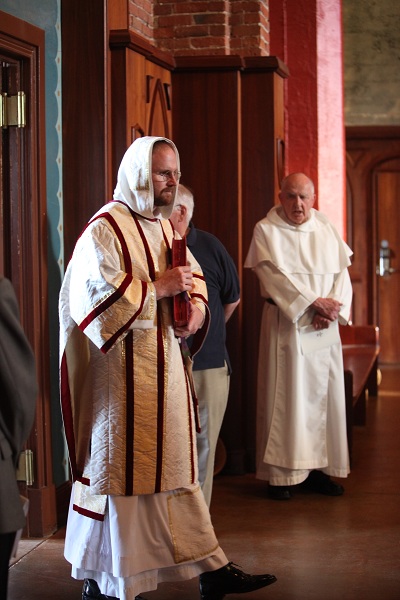There were exceptions made, however, for any form of liturgy that could show it was more than 200 years old. As a result, a few religious orders who had somewhat idiosyncratic customs were allowed to keep them as their own rite. The Dominican Order, founded in 1216, was one of them.
1240 copy of the Dominican Mass Book
Today is the feast day of the Dominicans' greatest saint, Thomas Aquinas, and the local studium celebrated a solemn high Mass in his memory, using the ancient rite that he himself would have known and celebrated in the 13th century, one whose shape was determined 400 or more years before that.
I went.
I became a Dominican after the changes, so that the Mass as it had been known to seven hundred years of my religious forbears was unknown to me. I am old enough, however, to remember what a solemn high Mass is, having been an altar server at the old Roman rite versions. I still knew the Latin music (even though the Dominican dialect is slightly different), so I can tell you that the two cantors were terrible.
The rite itself took 75 minutes, with priest, deacon, subdeacon and three young friars as acolytes. There were about 30 people in the choir stalls attending.
It was interesting, all-male, hierarchical, choreographically complex and strangely un-moving. Not fair to judge it on a single performance. These rituals are meant to be repeated over a lifetime and thru many scores of generations. And these friars themselves were largely new to it. But it did have a focus, a lack of audience-related anxiety and a seriousness compared to the modern version.
Moderns carry out the liturgy; medievals were carried along by it. These men were inhabiting ritual roles and carrying out precise ceremonial tasks. Their personalities were not at issue and only obliquely visible. By contrast, modern rites demand an almost unrelieved anxious attention to the moment by moment concoction of a "meaningful worship experience" by a performer-cleric for a consumer-audience.
I realize that it has been almost 30 years since I left. So the environment was both very familiar and felt, well, distant and other. And perhaps I would have felt less disconnected had my recent sense of the Church as active accomplice in the destruction of the West not been a barrier. Sadly, I found it hard to remember my participant Dominican self from the vantage of my current observer self.
Makes you wonder if the Boods are right, that a stable ego is an illusion.
---






1 comment:
"The Boods" LOL I've never heard that one before.
Post a Comment